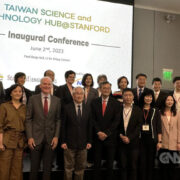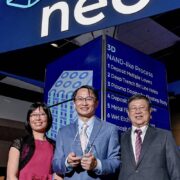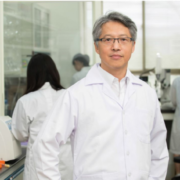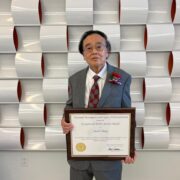在矽谷創業臺美人
作者 石清正
從六十年代起,開始有台灣留學生抵達這以創業盛行聞名於世的矽谷,留學生大都先入研究所進修,畢業後應聘到高科技公司的研發部門任職,接觸並掌握了新進的高科技術,也就較有創業機會。八十年代即有台美人創業有成,公司股票上市,也提供甚多就業機會。到了九十年代創業之舉更是風起雲湧、前仆後繼。筆者見識不廣,僅就所知舉些例子。
1969年李貴有與IBM同事創辦COMSIS 軟體公司,設計文通系統,替美國各級政府及其他國家設計交通系統,也曾參與台北捷運系 統的設計。後來公司移至麻里蘭州,員工達三百多人。1997年他把公司分成三部份出售後,回到聖荷西老家退休。他爲人恭謙誠懇,很熱心指導後輩創業。Solectron, Komag, IMR創立時都曾蒙受他的指點及幫助。對這位導師筆者甚爲感激及敬佩。
1971年 林忠雄創立 International Material Research (IMR)製造半導體製程需要的photo mask,後改行從事房地產,在聖荷西市中心擁有大片房地產,包括美國銀行大廈,最近從事電腦影像模擬。
1976年 陳文雄(Winston Chen)創立Compression Lab. 發展應用廣泛的資料壓縮 (data compression),他是這方面的元老。1982年股票上市,是矽谷最早成名的台僑科技公司。1997年與Vtel合併。接著他又創立 Vbits & Komodo Technology,這兩家先後爲網路巨業Cisco收購。
1978年 陳文雄(Winston Chen)經李貴有介紹加入 Solectron,不久林典謨、 陳秋月夫婦與林瑞松相繼加入,他有超人的遠見,預測電子代工的大市場,以卓越的管理方式,融合佛教哲理,把原來只有數十位員工替人焊接母版電路的公司,擴張成爲美國五百大公司之一,高峰時員工達五萬多人。1994年 退休後,致力教育及保護動物等慈善事業。除事業有相當成就外,他爲人謙和,處事平穩, 頗受眾人尊敬。林典謨是默默做事從不曝光的人,很樂意爲人服務。林瑞松是技術高手,專解難題。
1979年 林文釗創立EGW Publishing Company,出版多種英文雜誌及書籍。台灣人辦英文雜誌是很特殊的創業,可見他有過人的才氣。
1980年 黃復、邱俊邦及兩位惠普 (HP)同事共創 Integrated Device Tech-nology (IDT), 是首先製造高性能低耗電的 CMOS半導體的公司,製造產品進展順利,於1984年股票上市。後來黃復再創ULSI,製造主機矽片,邱俊邦則創Quality Semiconductor ,製造通訊用矽片,後併入IDT。他們兩人也是謙虛、誠懇的企業家。
1980年黃德慈、陳昭耀與楊東海創 立Compac,銷售電腦及零件。1993年與神達 (Mitac)合併改名 Synnex Information Tech ,經營資訊產品的設計與銷售,現年銷售額爲 32億美元,員工約1600人。
1981年顏永財、莊和子夫婦創辦Micro Lithography Inc.,專門製造 Pellicle 是保護photo mask的光罩護膜,現爲這類產品最大的製造公司。他們很熱心支持臺灣文化及社區活動,莊和子是現任橋務委員。
1982年台灣慶豐集團黃世惠、黃世雄兄弟在矽谷大舉投資,創辧五家高科技公司,其中Cogito製造硬磁碟機,Magnex製造磁碟機使用的磁頭,Genoa製造繪圖卡 (graphic card) 。
1982年 黃炎松等四人創辦ECAD,從事積體電路設計自動化(Electronic Design Automation-EDA)。1987年股票上市, 後來與SDA合併爲 Cadence。 1990年再創 Pic Design Systems與Quickturn合併,並於1994年股票上市。他是發展EDA的元老,善用孫子兵法。
1983年 陳都、陳俊雄與石清正創辦Komag製造薄膜硬碟片(thin film disk)用於磁碟,成爲這類產品最大製造公司。1987 年股票上市,高峰時員工達四千多人。在46年磁碟機發展過程中,單位價格下降了七百萬倍到0.1 cent / megabyte,歸功於一些突破, 其中之一就是使用薄膜碟片。研發該產品在六十年代即開始,但一直無法解決磁頭與磁碟間的機械性問題而無法生產,Komag在1984年解決此問題,而使該產品成爲主流。
1983年 林永壽創辦Lin Data,製造薄膜硬碟片,在1985年居領先地位,後因無法解決磁片的機械性問題而產生財務困難,於 1987年售於Nashua,於1995年改名爲 Store Media股票上市。
1983年李辰雄、李殿雄及王瑩宗創辦Wellex,從事承包電子產品製造(Electronic Manufacture Service-EMS),注重顧客需要及員工福利,公司低調穩定。
1984年 吳聰慶與同事創立Atmel,製造 nonvolatile memory 及 programmable IC,1989年股票上市。2000年時營業額約20億美元,員工八千多人。
1987年 林建昌等創立 Trident Microsystems 製造緣圖晶片(VGA graphic chip),在三十多家公司競争中,脱穎而出取得領先地位。1992年股票上市,年營業額一憶多美元。
1988年 林元闔創立Asante Technologies ,製造網路通訊用Ethernet card 及router等產品,1993年股票上市。
1988年陳勁初與同事參創立 BusLogic,製造 ASIC SCSI 矽片,1996與 Mykex 合併。
1991年胡智博創立Centrum Communication 從事遙控伺服器(remote access server), 1984年與 3-COM合併後,再創 AltiGen Communications,從事特殊電話交換糸統(PBX),結合電話、電腦及網路。
1993年洪順五、傅紅玉夫婦創辦AnaSpec,生產 Peptide Synthesis 生物科技實驗室中的試劑,是該業界中的傑出公司,在 全球對抗SARS中頗有重要貢獻。
1996年創業天才陳五福移陣矽谷,創立 Ardent Communications,九月後併入 CISCO,他有過人的先見及精力,創辦十多家公司,分散各地,爲了照顧這些公司,他經常往返其間,其夫人著有「從零到一百億」,描述他的創業生涯。
1998年吳振和所創的光林電子公司開始製造LED交通燈,現佔有20%的市場,名列第三位。
其他還有很多從台灣來的創業家,較知名的有:楊致遠(Yahoo)、李信麟(Qume) 、王大壯(Pantronic)、臧大化(Oak Technology)、孔繁建(Genelabs)、劉方訊(Opti)、李學勉(ISSI)、陳宏(Broadvision)、徐建國(Avanti)、梁見後(Super Micro)、段曉雷(Abovenet)、葉柄輝(Silicon Storage Tech)、胡國強(S3)、沙正治與黃志遠(SinaNet)等。
以上這些創業者,皆敬業勤奮、專業技術強、富有衝勁及冒險精神,大部份爲人很誠懇、謙和、有團隊精神及富領導能力。這些特質是在台灣與美國兩地教育環境下培養成長的,適合矽谷的創業環境。加上他們能融合美國的企業管理方式及制度,而奠定他們今日的成就。
綜合這些創業公司,大部份是與半導體、電腦、資訊、網路有關,最近有不少台美人進入生物科技業,這方面可能是下一波台美人創業的領域。 創業成功提供了社會不少就業機會,乃是創業者最感欣慰,而所獲得的成就感與財富,只是人生中的一小部份。在激烈的競爭中,仍能維持人格、健康、家庭、友情及助人,才是一個人更寶貴的財富。
Taiwanese-American Entrepreneurs in Silicon Valley
Ching-Cheng Shir / Oliver Demuth
Since the late 1960s, many Taiwanese-born engineers and entrepreneurs have made their mark in Silicon Valley. In this article we summarize the chronology of several Taiwanese contributions to the local business community. Although no two stories are the same, they share common themes and experiences.
Over the past five decades thousands of Taiwanese students have come to the United States for advanced educations. Many of these students have earned degrees and gained employment with Silicon Valley companies. Often they work in research and development and learn advanced technologies that result in new businesses. These new businesses create jobs, are then grown and taken public, and the process repeats itself. Their contributions on the technological landscape of Silicon Valley are profound. Here are a few of their stories.
1969-CSaremic© Le@ and his IBM colleagues founded Comsis, a transportation system design and consulting company. It was later relocated to Maryland and employed over 300 people. In 1997,Comsis was merged and Mr. Lee retired in San Jose. Mr. Lee was recognized by his colleagues as a kind, sincere and warm-hearted entrepreneur. He has offered his guidance and assistance to several other start-ups, including Solectron, Komag, and IMR. His contributions to those companies were significant.
1971-Stephen Lin founded International Material Research (IMR), a manufacturer of photo mask for semiconductor processing. Later he pursued ventures in real estate and at one point owned the Saint Clare Hilton in San Jose. Today, Dr. Lin owns the Bank of America Building and several other commercial properties in downtown San Jose. He is also involved in various applications of computer video animation.
1976-Wen Chen founded Compression Laboratory, a developer of data compression systems. The company had its initial public offering (IPO) in 1982,making it the first publicly traded Taiwanese-American enterprise in Silicon Valley. In 1997 Compression Labs merged with Vtel. After the merger, Dr. Chen founded V-Bits and Komodo Technology, both of which were acquired by the networking giant Cisco Systems in 1999 and 2000,respectively.
1978-Winston Chen joined Solectron on the recommendation of Clarence Lee. Shortly thereafter, Tim Lim, James Lin, and Julie Urn joined Dr. Chen at Solectron. The company started by soldering electronic components to motherboards.
Dr. Chen had a vision for the future of electronic manufacturing services (EMS). He made that vision a reality, using a management style that was rooted in Buddhist traditions and grew the company to over 50,000 employees at its peak and into the S&P 500 stock index. Solectron became a publicly traded company in 1989. In 1994,Dr. Chen retired and established a charitable foundation focused on educational and animal protection issues and is well respected in the community.
Tim Lim has quietly helped many people in the community, although he prefers to keep a low profile. James Lm was a skilled engineer known for his ability to solve complex technological problems.
1980-George Hwang, Chun P. Chiu, Frank Lee and one other colleagues from Hewlett-Packard founded Integrated Device Technology (IDT), a manufacturer of high performance, low-power consumption CMOS semiconductors. In only four years IDT became a public company. After this success, both men pursued new ventures. Mr. Hwang founded ULSI and Mr. Chiu started Quality Semiconductor, which later merged with IDT.
1980 – Wayne Lin founded EGW Publishing Company, which produced six English language magazines, the most well known being Popular Woodworking. Mr. LirVs unique talents allowed him to become one of few Taiwanese-American entrepreneurs in the English publishing industry.
1980 Robert Hyang, Steve Chen and Thomas Yang founded Compac, a distributer of computers and parts, which merged with Mitec in 1993 and changed its name to Synnex Information Technology (SIT). Its services range from design to distribution of information technology products. SIT recently reported annual revenue of $3.2 billion and a staff of more than 1600 employees.
1981-Chris & SandyYen founded Micro Lithography Inc., a manufacturer of pellicle, a protective film for photomask. The company is the largest producer of pellicle in the United States. Mr. & Mrs. Yen are active supporters in Taiwanese cultural and community activities.
1982 The Hwang Brothers from a large Taiwanese corporation known as Ching Fong came to Silicon Valley to pursue high-tech start-ups. Three of the companies they founded or invested in were Cogito, Magnex, and Genoa. Cogito manufactured hard disk drives. Magnex, acquired from Exxon, manufactured thin film heads for hard disk drives. Genoa, co-founded by Frank Lin, manufactured graphic cards for personal computers.
1982-Paul Huang and three others founded ECAD, an electronic design automation (EDA) company. ECAD went public in 1987; merged with SDA in 1988,and was later renamed Cadence.
1983-Tu Chen, Scott Chenk, and Ching-Cheng Shir founded Komag, a manufacturer of thin film disks used in hard disk drives. Komag went public in 1987 and at its peak was the world largest independent thin film disk maker, employing over 4000 people.
During the 45-year history of the hard disk, unit price has decreased more than 7 million times from $7000/megabyte to $0.001/megabyte. The primary technological break-through was the successful application of the thin-film disk, in addition to advanced magnetic heads. The innovation of the thin-filmed disk started in the 1960s in IBM laboratories, but the industry was plagued by mechanical problems with the head disk interface, and advancements were not made until Komag solved the problem in 1984.
1983-Yeong Lin founded Lin Data, another manufacturer of thin film disks. Lin Data was the market leader in 1985, but ran into mechanical problems with the head disk interface. Lin Data was acquired by Nashua in 1987,and subsequently sold in 1994. The name was changed to Store Media and the company was taken public in 1995.
1983-Danny Lee, Chern Lee and Jackson Wang founded Wellex, an electronic manufacturer services (EMS) company. Wellex, with emphasis on customers and employees, has been a stable company for 20 years.
1984-Tsung-Ching Wu, together with George and Gust Periegos, founded Atmel, a manufacturer of programmable chips and nonvolatile memory semiconductors. The company IPOed in 1989, and in year 2000 had over 8000 employees and annual revenues of more than $2 billion.
1987-Frank Lin founded Trident Microsystems, a maker of VGA graphic cards. Trident established market leadership in a highly competitive industry and went public in 1992.
1988-Jeff Lin with Wilson Wong founded Asante Technologies, a manufacturer of Ethernet adapter cards, and took the company public in 1993.
1988-Jesse Chen with his colleagues founded Bus Logic, a manufacturer of Asic and SCSI chips. Bus Logic merged with Mylex in1996.
1991-Gilbert Hu founded Centrum Communications, which engaged in remote access of computer systems. It merged with 3-Com in 1994. After the merger, Mr. Hu founded AltiGen Communications to market special PBX systems combining telephone and Internet capabilities.
1993-Frank and Anita Hung founded AnaSpec, a leader in Peptide Synthesis, manufacturing reagents used in biotech laboratory. They have contributed significantly in helping testing and combating SARS this year.
1996-Wu-Fu Chen, an entrepreneurial genius, moved to Silicon Valley from the east coast. He founded Ardent Communications, which was acquired by Cisco Systems nine month later. Mr. Chen is an entrepreneur with vision and unlimited energy. He is currently involved with more than ten different start-ups all over the world. His wife has written a book titled “From 0 to 10 Billions” about his life as an entrepreneur
1998-Chen-Ho Wu founded Leotek Electronics and entered the LED traffic signal light market in1998. Now Leotek owns 20 % of the market, one of top three leaders in that field.
There are many more entrepreneurs who came from Taiwan, some better known than others. Jerry Yang founded Yahoo, David Lee founded Qume, Stanley Wang founded Pantronic, David Tsang founded Oak Technology, Frank Kung founded Genelabs, Kenny Liu founded Opti, Jimmy Lee founded ISSI, Pehong Chen founded Broadvision, Gerry Hsu founded Avanti, Charles Liang founded Super Micro, Sherman Tuan founded Abovenet, Bing Yeh founded Silicon Storage Tech, Jackson Hu founded S3, and finally James Sha and Max Huang founded Sinanet.
These individuals all seem to share a work ethic, engineering talent, and risk-taking spirit acquired in their early years growing up in Taiwan. These character traits have translated well into the fast-paced, high-tech culture of Silicon Valley. Through their professional lives they exhibit integrity, teamwork, and modesty. Another component of their success has been their ability to embrace mainstream American business management and culture.
Most of these entrepreneurs found success within the high technology industry, including semiconductors, computers, and information technology systems. Recent market trends have resulted in more Taiwanese scientists and engineers entering the biotechnology field. Although very few of these new businesses have gone public, the biotech industry will probably produce another wave of Taiwanese entrepreneurial success.
摘自 三十而立 北加州台灣同鄉聯合會成立三十周年特刊/2003/09





